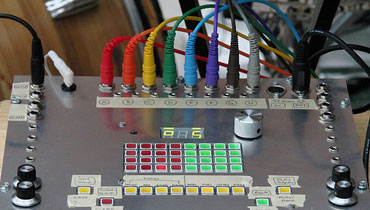The Octopus Project's 8-Speaker Live Surround-Sound System Page 2

(Above: The Bend Matrix Controller)
"On a couple of occasions, we'd send MIDI (rather than audio) to multiple channels, so each speaker's sound could have an independent decay. We'd set up 8 instances of a sampled piano, for instance (one for each channel), and then build MIDI clips that, when triggered, would route the live MIDI input from a keyboard to one of the eight samplers. So, using a Launchpad to trigger the MIDI clips or the audio-routing clips, we could manipulate the surround movement in a really hands-on way. Sometimes, this routing was sequenced - when things needed to be really tight, or when we were all busy playing other instruments. But the real-time stuff was definitely the most fun!
"And I forgot to mention effects! We'd send live inputs through delay chains that fed to each other around all 8 channels, which created this awesome circular rippling sound, and then we'd assign the delay times to knobs on a MIDI controller. When you'd simultaneously adjust 8 slightly different delay times, it would feel like your head was expanding. We used this same idea with a chain of filters, ring modulators, and bit crushers at various points."

(Above: Screen shot of the Ableton Live sequencer software)
And how about syncing everything to the video projections?
Toto: "[Our video pal] Wiley Wiggins came up with some pretty amazing images, but a lot of the footage came from us working together in various combinations. We'd all take a bunch of props and improvise weird scenes that Wiley would shoot in slow motion and make freaky edits with. Yvonne had the idea for [the patty-caking twin girls] and put that one together. I did a bunch of drawings and collages that Wiley and Josh would animate. And Josh had a lot of specific integrated sound/video ideas that he shot and edited.
"Once we had a big pile of material that Wiley had wrangled into shape with Motion and Final Cut, he brought it all into VDMX. We'd plan out each song so that clips and video events could be triggered from the Ableton Live rig that was running a lot of the music. This way, we could synchronize things pretty tightly without having to play to a prerecorded track."
- Log in or register to post comments




















































